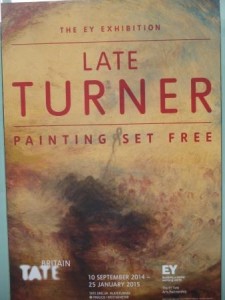Late Turner: Painting Set Free – Tate Britain, London

Very noble aims, then, of setting the public right on a few important points, but does the Tate achieve them? I think the exhibition does quite well in contextualising Turner’s late output. The organisation is thematic and also largely chronological, and shows Turner undertaking what might be expected of an artist at the time: he goes on painting trips, he paints historical and mythological scenes and landscapes and dabbles from time to time in something new like a steam train. He paints watercolours and then returns to them later either to rework the original, or to paint an oil from them. He gives advice to younger artists (I enjoyed the fact that they had included a work hung next to Turner’s at the Royal Academy exhibition in 1847. His materials (with paints and palette on display) look much the same as expected. Possibly not a completely demented old man, although the modern viewer must take into account that a man in his 70s was a rarer thing then than today, moreover one still sprightly enough to continue his career, and the concerns are therefore perhaps unsurprising.
There was certainly innovation going on in Turner’s later years though. One of the most effective rooms of the exhibition brings together works that he painted in square, round or octagonal formats. The techniques and colours employed are often as unexpected as the shapes and certainly unlike the work of his contemporaries, and point towards an artist unafraid to face down critical expectations. The exhibition then moves through to seascapes and late works, and it is here that the picture of Turner’s late works as something ‘set free’ from painterly convention becomes a little murkier. Many of the late canvases do seem to lean towards an economy of colour and detail which to the modern eye frankly looks modern. How much of this is an accident of history, though? What would Turner think if he saw some of these works, clearly abandoned or unfinished, framed and viewed as finished masterpieces? Did he intend the effects he achieved, or simply want to lay down a starting point to work from? We can guess at least partly at his intentions, which is exactly the gallery’s point in refuting the idea of Turner as a forerunner of Impressionism or a kind of abstract artist. Turner worked within a certain period and context, from which he cannot be removed, for all that he was innovative, daring and gifted right through to his later years.
It would seem then that the Tate’s exhibition does manage to refute the ideas that he was either senile or some kind of nineteenth century Jackson Pollock, by putting forward a solidly constructed view of what he was instead: of his time, but among the best of his time. I feel that I know his work a little better after seeing the exhibition, and will try not to rush to any of my own ill-formed conclusions about the man or his art myself in future.
